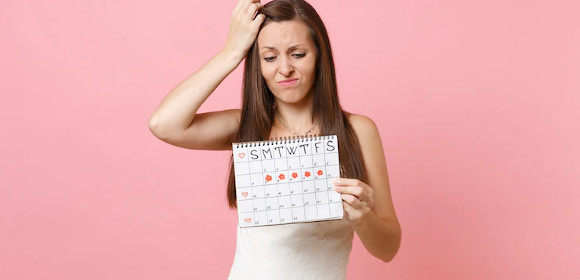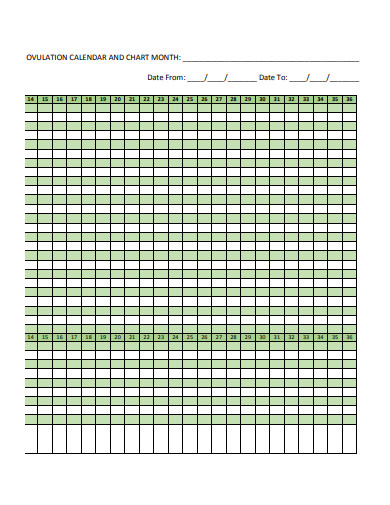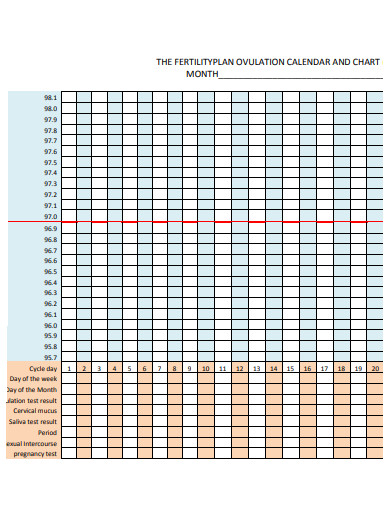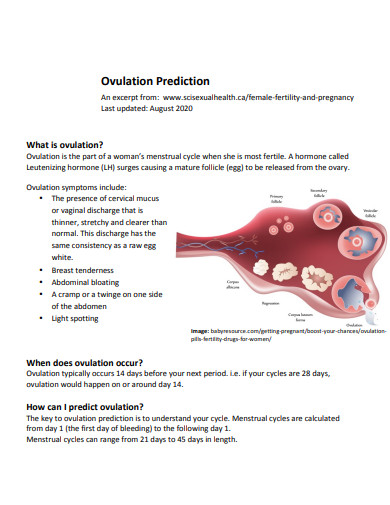3+ Ovulation Calendar Samples
Using an ovulation calendar might help you conceive or avoid pregnancy, depending on your situation. Some people use an ovulation calendar because they are unable to utilize birth control due to symptoms or medical concerns. For personal reasons, some people may not appreciate taking birth control. An ovulation calendar or timetable is a tool that records your menstrual cycle and helps you calculate your most viable days. This can assist to eliminate some of the guesswork involved in attempting to conceive. Before you think that there are a lot of mobile applications out there that you could use, it’s not the most accurate. Only you can get to know your period cycle– this might be hard, but fret no more! We’ve got you covered. In this article, we provide you with free and ready-made samples of Ovulation Calendars in PDF and DOC format that you could use for your benefit. Keep on reading to find out more!
1. Ovulation Calendar
2. Sample Ovulation Calendar
3. Ovulation Prediction Calendar
4. Ovulation Calendar Example
What Is an Ovulation Calendar?
An ovulation calendar or timetable might help you calculate your most fertile days by tracking your menstrual cycle. Calculate the average duration of your menstrual cycle to determine your ovulation timing. Calculators, charts, and calendars for ovulation prediction are all instruments that try to forecast when you’ll ovulate. These programs use your menstrual cycle length and the predicted window for ovulation to help you schedule sex for pregnancy. The most common appearance of a calendar tool is a regular calendar with the projected fertility windows underlined in each month.
How to Make an Ovulation Calendar
Based on previous cycles, a calendar will forecast when you are most likely to ovulate, providing you with a predicted viable window to boost your chances of conceiving. An Ovulation Calendar Template can help provide you with the framework you need to ensure that you have a well-prepared and robust calendar on hand. To do so, you can choose one of our excellent templates listed above. If you want to write it yourself, follow these steps below to guide you:
1. Take into account the information on your calendar.
As a best-guess estimate, use the facts you know. Try basal body temperature tracking for a more accurate ovulation day prediction.
2. Know how many days your period lasts on average.
This is the number of days between the start of one period and the start of the next. The simplest approach to figure this out is to keep track of your periods for several months.
3. Remember when you’re most fertile.
Consider that one to two days before you ovulate, you are most fertile. The closer you get to these ideal few days, the better your chances of getting pregnant during your fertile period, although conception can still happen if you’re in the broader fertility window.
4. Recognize the number of days in a cycle.
Cycle Day 1 is the day you first notice your period, Cycle Day 15 is 15 days later, and so on. The day before your next period, or the last day of your cycle, is a good indicator of how long your cycle will run.
5. Keep track of your fertile window.
Calculate your luteal phase duration by mapping your cycle on a calendar and counting back 14 days, or by using the estimated final day of your next cycle. If your periods are irregular, you can figure out your typical cycle length and use it to extend your reproductive window. You may also combine the information by counting how many days your period is shorter and longer.
FAQ
How can I figure out when I’ll ovulate?
The number of days between the first day of bleeding in your previous period and the first day of bleeding in your next period is the duration of your menstrual cycle.
How long does it take you to ovulate after your period?
Many women ovulate between 12 and 14 days following their last period, however other women have a naturally short cycle. They can ovulate as soon as six days after their last menstruation begins.
How long after your period do you have a chance of getting pregnant?
That implies you have around 6 days every month to become pregnant. This covers the day one of your ovaries produces an egg, known as ovulation, as well as the five days leading up to it. It’s crucial to have sex inside that time frame.
Knowing when you’re ovulating and having sex five days before and on the day of ovulation can help you get pregnant. To help you get started, download our easily customizable and comprehensive samples of Ovulation Calendars today!
Related Posts
FREE 9+ Workout Calendar Templates in Google Docs Google ...
FREE 10+ Sample Workout Calendar Templates in PDF MS Word
FREE 8+ Sales Calendar Templates in MS Word PDF | Apple Pages
FREE 21+ Business Calendar Templates in MS Word PDF | Google ...
FREE 14+ Birthday Calendar Templates in Google Docs MS Word ...
FREE 9+ Sample Teacher Calendar Templates in PDF MS Word
FREE 14+ Academic Calendar Templates in Google Docs MS ...
Steps for Creating a Grant Calendar [ How to Start, Steps to Create ...
FREE 8+ Sample Fiscal Calendar Templates in Excel PDF
FREE 18+ School Calendar Templates in PDF Google Docs | MS ...
FREE 19+ Training Calendar Templates in Google Docs MS Word ...
FREE 10+ Assessment Calendar Templates in PDF MS Word
FREE 10+ Calendar Timeline Templates in Google Docs MS Word ...
FREE 5+ Personal Calendar Samples in Excel PDF
FREE 6+ Sample Meal Calendar Templates in PDF MS Word | Excel




